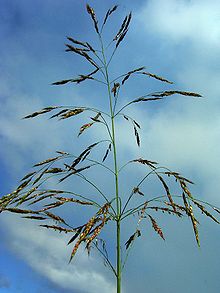Johnson grass: Difference between revisions
No edit summary |
Jboltonnal (talk | contribs) |
||
| Line 32: | Line 32: | ||
*[http://extension.missouri.edu/xplor/agguides/crops/g04872.htm University of Missouri Extension - Johnsongrass] |
*[http://extension.missouri.edu/xplor/agguides/crops/g04872.htm University of Missouri Extension - Johnsongrass] |
||
*[http://kswildflower.org/grass_details.php?grassID=37 Kansas Wildflowers and Grasses - JOHNSON GRASS page. Includes photos.] |
*[http://kswildflower.org/grass_details.php?grassID=37 Kansas Wildflowers and Grasses - JOHNSON GRASS page. Includes photos.] |
||
* [http://www.invasivespeciesinfo.gov/plants/johnsongrass.shtml Species Profile- Johnsongrass (''Sorghum halepense'')], National Invasive Species Information Center, [[United States National Agricultural Library]]. Lists general information and resources for Johnsongrass. |
|||
[[Category:Sorghum]] |
[[Category:Sorghum]] |
||
Revision as of 20:01, 15 February 2011
| Johnsongrass | |
|---|---|

| |
| Scientific classification | |
| Kingdom: | |
| (unranked): | |
| (unranked): | |
| (unranked): | |
| Order: | |
| Family: | |
| Genus: | |
| Species: | S. halepense
|
| Binomial name | |
| Sorghum halepense Pers.
| |
Johnsongrass (Sorghum halepense) is a plant in the grass family, Poaceae, native to the Mediterranean region, but growing throughout Europe and the Middle East. The plant has been introduced to all continents except Antarctica and most larger islands and archipelago. It reproduces by rhizomes and seeds.
Johnsongrass has been used for forage and to stop erosion, but it is often considered a weed for the following reasons:
- Foliage that becomes wilted from frost or hot dry weather can contain sufficient amounts of hydrogen cyanide to kill cattle and horses if it is eaten in quantity.
- The foliage can cause 'bloat' in such herbivores from the accumulation of excessive nitrates; otherwise, it is edible.
- It grows and spreads so quickly that it can 'choke out' other cash crops that have been planted by farmers.
This species occurs in crop fields, pastures, abandoned fields, rights-of-way, forest edges, and along streambanks. It thrives in open, disturbed, rich, bottom ground, particularly in cultivated fields. Johnsongrass resistant to the popular herbicide glyphosate has been found in Argentina and the USA [1][2][3]. It is considered to be one of the ten worst weeds in the world.[4]
References
- ^ Western Farm Press. Johnsongrass resistance to glyphosate confirmed in Argentina, Aug 28, 2006. (accessed 2010.01.06)
- ^ Monsanto. Glyphosate Resistant Johnsongrass Confirmed In Two Locations, March 12, 2008. (accessed 2010.01.06)
- ^ Delta Farm Press. Glyphosate-resistant johnsongrass in Mid-South, March 19, 2008 (accessed 2010.01.06)
- ^ BugwoodWiki[1] Holm, L. G., P. Donald, J. V. Pancho, and J. P. Herberger. 1977. The World's Worst Weeds: Distribution and Biology. The University Press of Hawaii, Honolulu, Hawaii. 609 pp.
External links
- Johnsongrass - US Department of Agriculture
- University of Missouri Extension - Johnsongrass
- Kansas Wildflowers and Grasses - JOHNSON GRASS page. Includes photos.
- Species Profile- Johnsongrass (Sorghum halepense), National Invasive Species Information Center, United States National Agricultural Library. Lists general information and resources for Johnsongrass.
